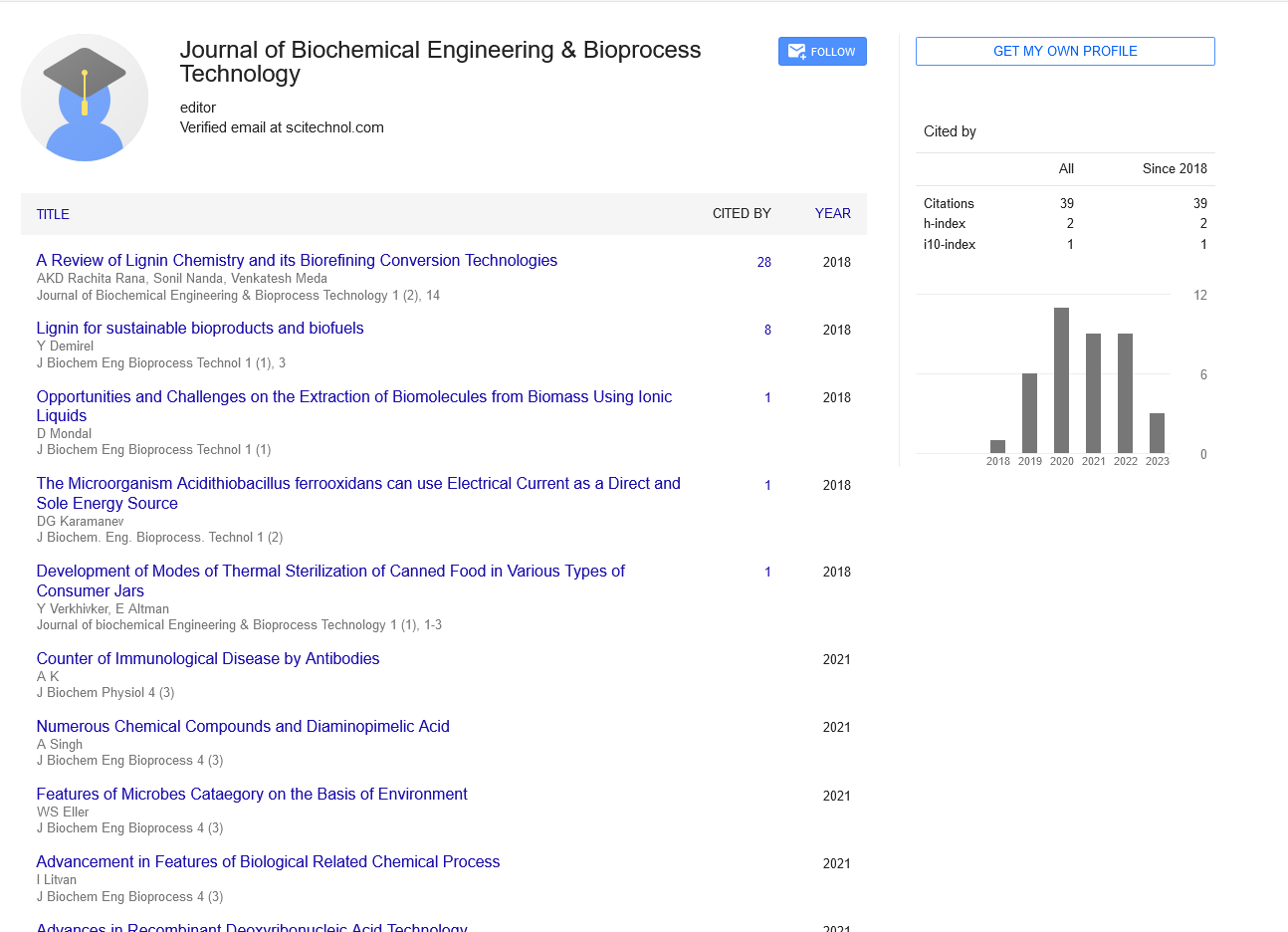Editorial, J Biochem Eng Bioprocess Vol: 4 Issue: 6
Absorbing Compounds found in Photosynthetic Organism
Raj Sekhar PH.D*,
Department of Biotechnology, Ramaiah Institute of Technology Bengaluru, India
*Corresponding Author:Raj Sekhar PH.D
Department of Biotechnology, Ramaiah Institute of Technology Bengaluru, India
E-mail: josephphilips@gmail.com
Received: Novemer 1, 2021; Accepted date: November 15, 2021; Published date: November 22, 2021
Abstract
Accessory pigments are light-absorbing compounds, found in photosynthetic organisms, that employment in conjunction with chlorophyll.
Keywords: Photosynthetic Organism
Editorial Note
Accessory pigments are light-absorbing compounds, found in photosynthetic organisms, that employment in conjunction with chlorophyll. They include other sorts of this pigment, like chlorophyll in green algal and better plant antennae, while other algae may contain chlorophyll c or d. additionally, there are many non-chlorophyll accessory pigments, like carotenoids or phycobiliproteins, which also absorb light and transfer that light energy to photosystem chlorophyll. A number of these accessory pigments, especially the carotenoids, also serve to soak up and dissipate excess light energy, or work as antioxidants.[the massive , physically associated group of chlorophylls and other accessory pigments is usually mentioned as a pigment bed
The different chlorophyll and non-chlorophyll pigments related to the photosystems all have different absorption spectra, either because the spectra of the various chlorophyll pigments are modified by their local protein environment or because the accessory pigments have intrinsic structural differences. The result's that, in vivo, a composite spectrum of these pigments is broadened and flattened such a wider range of visible and infrared is absorbed by plants and algae. Most photosynthetic organisms don't absorb green light well, thus most remaining light under leaf canopies in forests or under water with abundant plankton is green, a spectral effect called the "green window". Organisms like some cyanobacteria and alga contain accessory phycobiliproteins that absorb green light reaching these habitats.
In aquatic ecosystems, it's likely that the spectrum of water, alongside given and triton (dissolved and particulate organic matter, respectively), determines phototrophic niche differentiation. The six shoulders within the light absorption of water between wavelengths 400 and 1100 nm correspond to troughs within the collective absorption of a minimum of twenty diverse species of phototropic bacteria. Another effect is thanks to the general trend for water to soak up low frequencies, while gilvin and tripton absorb higher ones.
Reactive Oxygen Species (ROS) are highly destructive chemicals within plant systems. Antioxidants are important photo protective chemicals that guard plants from oxidative stress. Antioxidants are often classified into two groups: enzymatic and non-enzymatic in aquatic ecosystems, it's likely that the spectrum of water, along side gilvin and tripton (dissolved and particulate organic matter, respectively), determines phototrophic niche differentiation. The six shoulders within the light absorption of water between wavelengths 400 nm and 1100 nm correspond to troughs within the collective absorption of a minimum of twenty diverse species of phototropic bacteria. Another effect is thanks to the general trend for water to soak up low frequencies, while giving and triton absorb higher ones. . Of the non-enzymatic antioxidants, carotenoids have received relatively little attention in turf grass research.
However, carotenoids are vital antioxidants for buffering of singlet oxygen, dissipation of excess light energy through non-photochemical quenching, and harvesting light energy and channeling to the photosystem. Greater emphasis on carotenoids in turf grass research could provide several benefits. For instance, new cultivars might be selected that have improved high light tolerance due to greater zeaxanthin production. Additionally, xenobiotic could potentially increase carotenoid production, thereby increasing turf grass survivability under oxidative stress. Previous research indicates turf grass species have robust carotenoid pool levels like vegetables and herbs consumed for his or her phytonutrient benefits. The photosynthetic pigments of phototrophic microorganisms cover different regions of the solar light spectrum. Utilization of the sunshine spectrum are often interpreted in terms of classical niche theory, because the light spectrum offers opportunities for niche differentiation and allows coexistence of species absorbing different colors of sunshine . However, which spectral niches are available for phototrophic microorganisms? Here, we show that the solution is hidden within the vibrations of the water molecule. Water molecules absorb light at specific wavebands that match the energy required for his or her stretching and bending vibrations. Although light absorption at these specific wavelengths appears only as subtle shoulders within the spectrum of pure water, these subtle shoulders create large gaps within the underwater light spectrum thanks to the exponential nature of sunshine attenuation. Model calculations show that the wavebands between these gaps define a series of distinct niches within the underwater light spectrum. Strikingly, these distinct spectral niches match the sunshine absorption spectra of the main photosynthetic pigments on our planet. This means that vibrations of the water molecule have played a serious role within the ecology and evolution organisms.
 Spanish
Spanish  Chinese
Chinese  Russian
Russian  German
German  French
French  Japanese
Japanese  Portuguese
Portuguese  Hindi
Hindi 